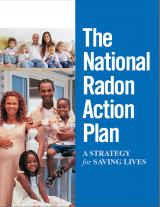by Brianna Crandall — November 11, 2015—The U.S. Environmental Protection Agency (EPA), American Lung Association, and other partners announced a strategy on November 10 designed to help prevent 3,200 lung cancer deaths annually by 2020 through radon exposure reduction strategies.
The goal to save these lives will be achieved by reducing high radon levels in 5 million homes, apartments, schools and childcare centers, says EPA. Exposure to radioactive radon gas is said to be the second leading cause of lung cancer in America.

Strategies include requiring radon testing and reduction systems in housing finance and insurance programs, and through building codes
The National Radon Action Plan: A Strategy for Saving Lives sets out strategies to drive the changes needed to reduce exposure to radon. Strategies include requiring radon testing and reduction systems as a standard practice in housing finance and insurance programs, and institutionalizing radon risk reduction through building code requirements for construction and renovation.
The strategy builds on the successes of the 2011 Federal Radon Action Plan, which has led to protection from radon in more than 105,000 multifamily homes financed by HUD by increasing visibility of the radon issue and incentivizing action, among other initiatives by the federal government.
The new plan broadens the scope and reach of the Federal Radon Action Plan by including the health, scientific and technical expertise of the national partners and aligning federal efforts with those of other national organizations dedicated to lowering radon exposure.
The partnership includes three federal departments and agencies, and nine national organizations. In addition to EPA, the federal partners are the Department of Housing and Urban Development (HUD) and the Department of Health and Human Services (HHS).
The organizations are: the American Lung Association (ALA), American Association of Radon Scientists and Technologists (AARST), the American Society of Home Inspectors (ASHI), Cancer Survivors Against Radon (CanSAR), the Children’s Environmental Health Network (CEHN), Citizens for Radioactive Radon Reduction, the Conference of Radiation Control Program Directors (CRCPD), the Environmental Law Institute (ELI), and the National Center for Healthy Housing (NCHH).
EPA’s Radon Web page explains that radon is a radioactive gas that comes from the decay of uranium in the ground. Nearly all soils contain some naturally occurring uranium. Radon seeps up from the soil into buildings where it can accumulate to high levels. Since radon is invisible and odorless, dangerous levels can exist indoors without occupants knowing.
Testing is the only way to know the radon level in a home or school, according to EPA. Exposure to radon causes an estimated 21,000 lung cancer deaths annually. After smoking, radon is the second-leading cause of lung cancer. However, affordable measures effective in reducing radon indoors are available, and when employed can prevent radon-induced lung cancer and save lives.
The new National Radon Action Plan: A Strategy for Saving Lives is available from the EPA Web site.





